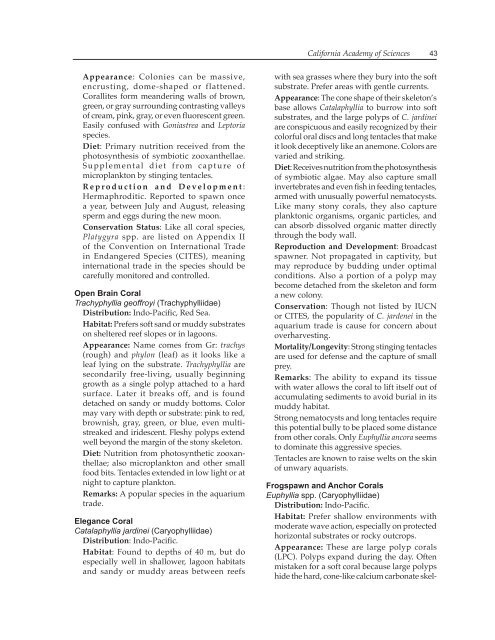THE STEINHART AQUARIUM - Gulf of Guinea Science ...
THE STEINHART AQUARIUM - Gulf of Guinea Science ...
THE STEINHART AQUARIUM - Gulf of Guinea Science ...
Create successful ePaper yourself
Turn your PDF publications into a flip-book with our unique Google optimized e-Paper software.
Appearance: Colonies can be massive,<br />
encrusting, dome-shaped or flattened.<br />
Corallites form meandering walls <strong>of</strong> brown,<br />
green, or gray surrounding contrasting valleys<br />
<strong>of</strong> cream, pink, gray, or even fluorescent green.<br />
Easily confused with Goniastrea and Leptoria<br />
species.<br />
Diet: Primary nutrition received from the<br />
photosynthesis <strong>of</strong> symbiotic zooxanthellae.<br />
Supplemental diet from capture <strong>of</strong><br />
microplankton by stinging tentacles.<br />
R e p r o d u c t i o n a n d D e v e l o p m e n t :<br />
Hermaphroditic. Reported to spawn once<br />
a year, between July and August, releasing<br />
sperm and eggs during the new moon.<br />
Conservation Status: Like all coral species,<br />
Platygyra spp. are listed on Appendix II<br />
<strong>of</strong> the Convention on International Trade<br />
in Endangered Species (CITES), meaning<br />
international trade in the species should be<br />
carefully monitored and controlled.<br />
Open Brain Coral<br />
Trachyphyllia ge<strong>of</strong>froyi (Trachyphylliidae)<br />
Distribution: Indo-Pacific, Red Sea.<br />
Habitat: Prefers s<strong>of</strong>t sand or muddy substrates<br />
on sheltered reef slopes or in lagoons.<br />
Appearance: Name comes from Gr: trachys<br />
(rough) and phylon (leaf) as it looks like a<br />
leaf lying on the substrate. Trachyphyllia are<br />
secondarily free-living, usually beginning<br />
growth as a single polyp attached to a hard<br />
surface. Later it breaks <strong>of</strong>f, and is found<br />
detached on sandy or muddy bottoms. Color<br />
may vary with depth or substrate: pink to red,<br />
brownish, gray, green, or blue, even multistreaked<br />
and iridescent. Fleshy polyps extend<br />
well beyond the margin <strong>of</strong> the stony skeleton.<br />
Diet: Nutrition from photosynthetic zooxanthellae;<br />
also microplankton and other small<br />
food bits. Tentacles extended in low light or at<br />
night to capture plankton.<br />
Remarks: A popular species in the aquarium<br />
trade.<br />
Elegance Coral<br />
Catalaphyllia jardinei (Caryophylliidae)<br />
Distribution: Indo-Pacific.<br />
Habitat: Found to depths <strong>of</strong> 40 m, but do<br />
especially well in shallower, lagoon habitats<br />
and sandy or muddy areas between reefs<br />
California Academy <strong>of</strong> <strong>Science</strong>s<br />
43<br />
with sea grasses where they bury into the s<strong>of</strong>t<br />
substrate. Prefer areas with gentle currents.<br />
Appearance: The cone shape <strong>of</strong> their skeleton’s<br />
base allows Catalaphyllia to burrow into s<strong>of</strong>t<br />
substrates, and the large polyps <strong>of</strong> C. jardinei<br />
are conspicuous and easily recognized by their<br />
colorful oral discs and long tentacles that make<br />
it look deceptively like an anemone. Colors are<br />
varied and striking.<br />
Diet: Receives nutrition from the photosynthesis<br />
<strong>of</strong> symbiotic algae. May also capture small<br />
invertebrates and even fish in feeding tentacles,<br />
armed with unusually powerful nematocysts.<br />
Like many stony corals, they also capture<br />
planktonic organisms, organic particles, and<br />
can absorb dissolved organic matter directly<br />
through the body wall.<br />
Reproduction and Development: Broadcast<br />
spawner. Not propagated in captivity, but<br />
may reproduce by budding under optimal<br />
conditions. Also a portion <strong>of</strong> a polyp may<br />
become detached from the skeleton and form<br />
a new colony.<br />
Conservation: Though not listed by IUCN<br />
or CITES, the popularity <strong>of</strong> C. jardenei in the<br />
aquarium trade is cause for concern about<br />
overharvesting.<br />
Mortality/Longevity: Strong stinging tentacles<br />
are used for defense and the capture <strong>of</strong> small<br />
prey.<br />
Remarks: The ability to expand its tissue<br />
with water allows the coral to lift itself out <strong>of</strong><br />
accumulating sediments to avoid burial in its<br />
muddy habitat.<br />
Strong nematocysts and long tentacles require<br />
this potential bully to be placed some distance<br />
from other corals. Only Euphyllia ancora seems<br />
to dominate this aggressive species.<br />
Tentacles are known to raise welts on the skin<br />
<strong>of</strong> unwary aquarists.<br />
Frogspawn and Anchor Corals<br />
Euphyllia spp. (Caryophylliidae)<br />
Distribution: Indo-Pacific.<br />
Habitat: Prefer shallow environments with<br />
moderate wave action, especially on protected<br />
horizontal substrates or rocky outcrops.<br />
Appearance: These are large polyp corals<br />
(LPC). Polyps expand during the day. Often<br />
mistaken for a s<strong>of</strong>t coral because large polyps<br />
hide the hard, cone-like calcium carbonate skel-


